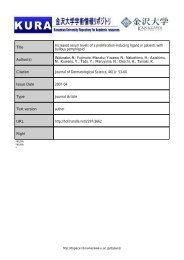transmembrane domain ECD: extracellular domain ICD
transmembrane domain ECD: extracellular domain ICD
transmembrane domain ECD: extracellular domain ICD
Create successful ePaper yourself
Turn your PDF publications into a flip-book with our unique Google optimized e-Paper software.
Cloning of two members of the calcitonin-family receptors from stingray, Dasyatis<br />
akajei: Possible physiological roles of the calcitonin family in osmoregulation<br />
Nobuo Suzuki a* , Toshio Sekiguchi b , Honoo Satake b , Kanoko Kato c , Yudai Nishiyama c ,<br />
Hideya Takahashi c,d , Janine A. Danks e , T. John Martin f , Atsuhiko Hattori g , Masaki<br />
Nakano g , Makiko Kakikawa h , Sotoshi Yamada h , Maho Ogoshi c , Susumu Hyodo i , Yoko<br />
Yamaguchi i , Vishwajit S. Chowdhury j , Kazuichi Hayakawa k , Hisayuki Funahashi m ,<br />
Tatsuya Sakamoto c and Yuichi Sasayama a<br />
a<br />
Noto Marine Laboratory, Institute of Nature and Environmental Technology, Kanazawa University,<br />
Housu-gun, Ishikawa 927-0553, Japan; b Suntory Institute for Bioorganic Research, Mishima-gun,<br />
Osaka 618-8503, Japan; c Ushimado Marine Institute, Okayama University, Ushimado, Okayama<br />
701-4303, Japan; d Institute of Science and Technology, Niigata University, Niigata 950-2181, Japan;<br />
e f<br />
School of Medical Sciences, RMIT University, Bundoora 3083, Australia; St. Vincent's Institute of<br />
Medical Research, 41 Victoria Parade, Fitzroy 3065, Australia; g Department of Biology, College of<br />
Liberal Arts and Sciences, Tokyo Medical and Dental University, Ichikawa-city, Chiba 272-0827;<br />
h<br />
Institute of Nature and Environmental Technology, Kanazawa University, Kanazawa-city, Ishikawa<br />
920-1192, Japan; i Atmosphere and Ocean Research Institute, University of Tokyo, Kashiwa-city, Chiba<br />
277-8564 Japan; j International Education Center, Faculty of Agriculture, Kyushu University, Fukuoka<br />
812-8581, Japan; k Faculty of Pharmaceutical Science, Institute of Medical, Pharmaceutical and<br />
Health Sciences, Kanazawa University, Kanazawa-city, Ishikawa 920-1192; m Showa University,<br />
School of Medicine, Department of Anatomy, Shinagawa-ku, Tokyo 142-8555, Japan<br />
Correspondence to: Dr. N. Suzuki, a Noto Marine Laboratory, Institute of Nature and Environmental<br />
Technology, Kanazawa University, Ogi, Noto-cho, Ishikawa 927-0553, Japan. Tel.: 81-768-74-1151; Fax<br />
81-768-74-1644; e-mail: nobuos@staff.kanazawa-u.ac.jp<br />
Keywords: calcitonin; calcitonin gene-related peptide; tissue expression; elasmobranch<br />
Abbreviations: bp, base pair(s); cDNA, DNA complementary to RNA; CGRP, calcitonin gene-related<br />
peptide; calcitonin, CT; calcitonin receptor, CTR; calcitonin-receptor-like receptor, CRLR; mRNA,<br />
messenger RNA; PCR, polymerase chain reaction; RACE, rapid amplification of cDNA ends; RT-PCR,<br />
reverse transcription-polymerase chain reaction.<br />
1
Abstract In cartilaginous fish, two cDNAs encoding calcitonin-family receptors were<br />
isolated for the first time from the stingray brain. The open reading frame of one receptor<br />
cDNA coded a 525-amino acid protein. The amino acid identity of this receptor to human<br />
calcitonin-receptor-like receptor (CRLR) is 64.5%, frog CRLR is 64.7%, and flounder<br />
CRLR is 61.2% and this was higher than to human calcitonin receptor (CTR) (46.1%),<br />
frog CTR (54.7%), and flounder CTR (48.9%). We strongly suggested that this receptor is<br />
a ray CRLR based on phylogenetic analysis. In case of the second receptor, amino acid<br />
identity among CRLRs (human 50.5%; frog 50.7%; flounder 48.0%) and CTRs (human<br />
43.2%; frog 49.1%; flounder 41.8%) was similar. From phylogenetic analysis of both<br />
CRLRs and CTRs, we believe that this receptor is ray CTR. The expression of ray CRLR<br />
mRNA was predominantly detected in the nervous system (brain) and vascular system<br />
(atrium, ventricle, and gill), which reflects the similar localization of CGRP in the nervous<br />
and vascular systems as mammals. It was observed that the second receptor was expressed<br />
in several tissues, namely cartilage, brain, pituitary gland, gill, atrium, ventricle, pancreas,<br />
spleen, liver, gall bladder, intestine, rectal gland, kidney, testis and ovary. This<br />
localization pattern was very similar to flounder CTR. Both receptor mRNAs were<br />
strongly expressed in the gill. This suggests that the calcitonin-family members are<br />
involved in the osmoregulation of stingray as this fish is known to be euryhaline. When a<br />
stingray was transferred to diluted seawater (20% seawater), the expression of both<br />
receptors significantly decreased in the gill. Similar results were obtained in the kidney of<br />
the stingray. Thus, our cloning and isolation of both receptors in the stingray will be<br />
helpful for elucidation of their physiological role (s) such as osmoregulation including<br />
calcium metabolism of cartilaginous fish.<br />
2
1. Introduction<br />
Calcitonin gene-related peptide (CGRP) is a 37 amino acid hormone whose mRNA is<br />
co-encoded with calcitonin (CT) mRNA on a single gene (Amara et al., 1982). In mammals,<br />
the mRNA synthesis of two hormones is controlled by tissue-specific alternative splicing;<br />
CGRP precursor mRNA is synthesized in the neural tissues; CT precursor mRNA is<br />
synthesized in the thyroidal C-cells (Rosenfeld et al., 1983). Since CGRP exists widely in<br />
the central nervous system (Rosenfeld et al., 1983; Gibson et al., 1984), it is suggested that<br />
CGRP plays role as a neuromediator or neuromodulator (Lafont et al., 2007). In addition,<br />
CGRP is synthesized in the heart and blood vessels to control blood flow by its potent<br />
vasodilatory actions (Mulderry et al., 1985; Wimalawansa, 1997; Brain and Grant, 2004).<br />
In teleosts, the presence of CGRP immunoreactive substances has been demonstrated in<br />
trout (Fouchereau-Peron et al., 1990). Jansz and Zandberg (1992) characterized the CGRP<br />
gene of salmon, suggesting that salmon CGRP is the product of the alternative splicing of<br />
the CT/CGRP gene, common to mammals. We also cloned a part of genomic DNA<br />
including the CGRP gene from flounder (Paralichthys olivaceus) and detected mRNA<br />
expression in the brain and heart (Suzuki et al., 2001), suggesting that CGRP acts as a<br />
neuropeptide and a vasodilator in fish as well as mammals. As CGRP immunoreactivity has<br />
been detected in the brain of small-spotted dogfish (Molist et al., 1995), and may be quite<br />
important in homeostasis in all fish including cartilaginous fish (Lafont et al., 2007). On the<br />
other hand, calcitonin receptor-like receptor (CRLR) functions to a receptor for CGRP<br />
when it is co-expressed with RAMP1 (McLatchie et al., 1998; Husmann et al., 2000;<br />
Sexton et al., 2001). The distribution and expression analysis of CRLR under various<br />
physiological and environmental conditions could contribute to the understanding of<br />
physiological functions of CGRP in cartilaginous fish.<br />
3
To study the physiological role of CGRP in cartilaginous fish, the full coding region of<br />
CRLR was sequenced from the brain of stingray and the mRNA expression in the various<br />
tissues was analyzed. In the process of CRLR cloning, a second member of the<br />
calcitonin-family receptors was isolated and cloned. Based on the data of multiple<br />
alignment, phylogenetic analysis and tissue distribution pattern, it is apparent that this<br />
receptor is equivalent to the stingray calcitonin receptor (CTR). In addition, it was found<br />
that the expression of two receptors was decreased in the gill and kidney when the rays<br />
were transferred to diluted seawater. Thus, this is the first study that identifies two members<br />
of calcitonin-family receptors in cartilaginous fish and indicates the possible physiological<br />
roles of CT and CGRP in the osmoregulation of stingray.<br />
2. Materials and methods<br />
2.1. Animals<br />
The brain of male stingray (Dasyatis akajei) was used for PCR amplification. Male and<br />
female stingrays were used for the analysis of tissue-specific expression and adaptation in<br />
seawater. The original concentration of seawater (100%) and diluted seawater (20%) were<br />
used for this study. The animals were anesthetized with ethyl 3-amino-benzoate,<br />
methanesulfonic acid salt (Sigma-Aldrich Inc., MO, USA) and then dissected for tissue<br />
preparation.<br />
All experimental procedures were conducted in accordance with the Guide for the<br />
Care and Use of Laboratory Animals prepared by Kanazawa University.<br />
2.2. PCR amplification<br />
Total RNAs were prepared using a total RNA isolation kit (Nippon Gene, Tokyo,<br />
4
Japan) from the brains of stingray. RT-PCR was performed using Oligotex-dT 30 Super<br />
(Takara, Kusatsu, Japan) as an oligo dT primer to prevent genomic DNA contamination<br />
(Suzuki et al., 1997). The PCR primers were designed at the well-conserved region of the<br />
mammalian CRLR and CTR cDNA sequences (Figure 1). The primer sequences were:<br />
5’A-GYAAYMGXACXTGGGAYGG; 5’B-GAYTAYTTYCCXGAYTTYGA;<br />
3’A-CCYTCRCAXARCATCCARAA; 3’B:CATCCARAARTARTTRCA (Suzuki et al.,<br />
2000). The 1st and the nested-PCR (1st PCR: 5’A/3’A primer set; 2nd PCR: 5’B/3’B<br />
primer set) were performed using a Taq polymerase and an additional buffer (Takara Bio<br />
Inc., Otsu, Japan). The PCR parameters were 35 cycles of 96°C for 30s, 45°C for 1 min,<br />
and 72°C for 2 min. The sequencing of the PCR products of the expected length (422 bp)<br />
was performed by Dragon Genomics Center, Takara Bio Inc. (Mie, Japan).<br />
2.3. RACE amplification of receptors cDNAs in stingray<br />
Total RNA (1 �g) was obtained from the stingray brain. The complete sequences of the<br />
two receptors were obtained by 5’- and 3’-RACE method using a kit 5' RACE System,<br />
Version 2.0 and 3' RACE System for Rapid Amplification of cDNA Ends, respectively<br />
(Invitrogen, CA, USA). The primer locations for two receptors were described in<br />
supplementary figures. RACE was performed using the respective gene-specific primer and<br />
the primer of adaptor sequences in the kit. The products were sequenced on an ABI PRISM<br />
3130 sequencer (Applied Biosystems, CA, USA) using BigDye terminators.<br />
2.4. Expression analysis<br />
Total RNAs were prepared from the cartilage, brain, pituitary gland, gill atrium,<br />
ventricle, pancreas, spleen, liver, gall bladder, intestine, rectal gland, kidney, and testis of<br />
5
male stingray, as well as the ovary of female stingray using a total RNA isolation kit<br />
(Nippon Gene). RT-PCR was performed using the primer set (CRLR<br />
5’:AGACTTCGATCCATCAGA; CRLR 3’: AGTCAATGCTGTCTTTA; CTR-like 5’:<br />
CACGGAAAAGGTCACC; CTR-like 3’: AGTGAACAAAGAGTAATAT). The<br />
conditions for PCR amplification were 40 cycles of denaturation for 0.5 min at 96°C,<br />
annealing for 1 min at 60°C, and extension for 2 min at 72°C, followed by a single cycle<br />
at 72°C for 30 min. In case of the �-actin cDNA (AB675482), the amplification using a<br />
primer set (5’: TTGGCAATGAGCGATTCAGA; 3’:<br />
CACAGGATTCCATACCCAAGAAA) were consisted of 25 cycles of denaturation for<br />
0.5 min at 96°C, annealing for 1 min at 60°C, and extension for 2 min at 72°C, followed<br />
by a single cycle at 72°C for 15 min. The PCR products were analyzed on 2.5% NuSive<br />
GTG agarose gel (FMC Bioproducts, ME, USA) and stained with ethidium bromide.<br />
2.5. Phylogenetic analysis<br />
The amino acid sequences were aligned using the CLUSTAL program (Higgins and<br />
Sharp 1988). After removing gaps, the verified alignments were used to construct<br />
phylogenetic trees. The trees were calculated using MEGA program based on the<br />
neighbor-joining method (Saitou and Nei 1987; Kumar et al. 2001). The sequences used as<br />
follow: Human-CRLR, NP_005786; Pig-CRLR, Q867C1; Dog-CRLR, XP_545560;<br />
Mouse-CRLR, NP_061252; Xenopus-CRLR, NP_001016893; Fugu-CRLR2, BAE45313;<br />
Salmon-CRLR, CAD48406; Flounder-CRLR, AB035314; Fugu-CRLR1, BAE45312;<br />
Flounder-CTR, AB035315; Chicken-CTR, XP_425985; Bullfrog-CTR, Q28DX2;<br />
Fugu-CTR, BAE76018; Medaka-CTR, AAI19273; Pig-CTR, AAA31023; Mouse-CTR,<br />
AAI19273; Human-CTR, NP_001733; Dog-CTR, XP_539423; Ascidian-CTR,<br />
6
BAI63096; Human-CRHR1, NP_004373.<br />
2.6. Analysis of the mRNA expression of both ray CRLR and CTR-like receptors in the gill<br />
and kidney after transfer to diluted seawater.<br />
Seawater adapted-stingrays (n = 8, both sexes) were gradually transferred into diluted<br />
seawater. In the first day, the stingrays were transferred to 80% seawater and then kept for<br />
6 hours followed by putting them into 60% seawater for remaining of the day. In the next<br />
day, the stingray were kept in 40% seawater for 6 hours, and then transferred into 20%<br />
seawater. After keeping the stingrays in 20% seawater for 12 hours, the stingrays were<br />
anesthetized with ethyl 3-aminobenzoate, methanesulfonic acid salt (Sigma-Aldrich). The<br />
gill and kidney were collected from stingray under proper anesthetic condition. Also, the<br />
seawater-adapted stingrays (n = 8, both sexes) were anesthetized with ethyl<br />
3-aminobenzoate, methanesulfonic acid salt (Sigma-Aldrich). The gill and kidney were<br />
removed from the seawater stingrays.<br />
Total RNA was prepared using a total RNA isolation kit for fibrous tissue and<br />
complementary DNA synthesis was performed (RNase Easy Fibrous Mini-Kit, Qiagen<br />
GmbH, Hilden, Germany). The real-time PCR amplification was analyzed with a<br />
BIO-RAD iCycler (BIO-RAD, Hercules, CA) using the primers for CRLR (5':<br />
GGAGAAGCTAAAGACAGCATTGACT; 3': CAGCAGCGAAGCCACTGATA') and<br />
for CTR-like (5': GGAAAAGGTCACCAAGATTTGC; 3':<br />
AGTCCATGTTCGGTTGCTCTCT). The annealing temperature in the amplification of<br />
both CRLR and CTR-like cDNAs was 63°C. The amplified PCR products have been<br />
verified by sequencing to confirm its sequences. The detailed conditions of PCR were<br />
described in our previous study (Takahashi et al., 2007). The CRLR and CTR-like mRNA<br />
7
levels were normalized to the �-actin mRNA level measured by above described primer<br />
set (5’: TTGGCAATGAGCGATTCAGA; 3’: CACAGGATTCCATACCCAAGAAA).<br />
2.7. Statistical analysis<br />
Real-time PCR was performed and the data were analyzed using the Student’s t-test.<br />
The significance level was P
The amino acid identity of the second stingray receptor (see, supplementary data) was<br />
similar to CRLRs (human 50.5%; frog 50.7%; flounder 48.0%) and CTRs of other species<br />
(human 43.2%; frog 49.1%; flounder 41.8%). After alignment of flounder CRLR, flounder<br />
CTR, human CRLR, human CTR, and two stingray receptors, three potential sites<br />
(Asn-X-Ser/Thr) for N-linked glycosylation, which are conserved in mammalian CRLR and<br />
CTR, were identified in stingray receptors before the first putative <strong>transmembrane</strong> <strong>domain</strong>.<br />
Furthermore, 12 cysteines were conserved among CRLRs, CTRs, and stingray receptors.<br />
These glycosylation sites and cysteines are suggested to be important for ligand binding (Qi<br />
et al., 1997; Ho et al., 1999). Using BLAST against the DDBJ/NCBI protein database,<br />
furthermore, we confirmed that the sequences are most similar to CRLR and CTR. Thus,<br />
we concluded that two receptors belong to the calcitonin-family receptors.<br />
3.3. Phylogenetic analysis of calcitonin-family receptors<br />
The phylogenetic tree was determined for the known calcitonin-family receptors<br />
together with stingray receptors (see, supplementary data). As a result, the stingray<br />
receptors were located with CRLR and CTR in other animals. The first stingray receptor<br />
branched from teleost CRLR and composed of a clade of mammalian and xenopus CRLR.<br />
This result strongly supports that the amino acid sequence was that of stingray CRLR (ray<br />
CRLR). The second stingray receptor, co-located with flounder CTR, and was placed<br />
between the CRLRs clade and the non-mammalian CTRs clade (see, supplementary data).<br />
We previously reported amino acid sequences of both CT and CGRP in flounder<br />
(Suzuki et al., 2001). The amino acid sequence of flounder CT was more similar to<br />
teleosts (78–100%), salamander (81%), reptiles (84%), and chicken (84%) than those of<br />
stingray (72%) and frogs (56–78%), and it is largely different from that of mammals<br />
9
(31–50%). However, the predicted amino acid sequence of flounder CGRP was more<br />
conserved than CT among vertebrates and showed 78%, 78%, 78%, 81%, and 73–78%<br />
identity to salmon, cod, frog, chicken, and mammalian CGRPs, respectively. Among<br />
vertebrates, CGRP is a well-conserved molecule during evolution while CT is quite varied.<br />
Corresponding to sequence changes in ligand (CT), the receptor (CTR) seems to be varied<br />
largely. Thus, it is highly likely that the second receptor is the stingray equivalent of CTR<br />
(ray CTR-like).<br />
3.4. Expression of ray CRLR and ray CTR-like mRNAs in different tissues<br />
Specific PCR products of ray CRLR mRNA were amplified from brain, gill, atrium<br />
and ventricle and detected in cartilage, pituitary gland, spleen, liver, gall-bladder, intestine,<br />
rectual gland, kidney, testis and ovary (Fig. 2). Pancreas did not show any expression with<br />
the present conditions (Fig. 2). The ray CRLR mRNA expression was found in brain, heart<br />
and intestine and this same as seen in mammals (Eysselein et al., 1991; Poyner, 1992),<br />
suggesting similar functions in those tissues. In spleen, relatively high expression of ray<br />
CRLR was detected. Arlot-Bonnemains et al. (1991) reported that CGRP-specific binding<br />
in trout tissues is high in the spleen although the function has not yet been elucidated. In the<br />
early development of gut in zebrafish, the number of nerve cell bodies and fibers gradually<br />
increased and CGRP was detected in these nerve cells (Olsson et al., 2008). In another<br />
study, cod CGRP (10 -9 –10 -7 M) inhibited the motility of spontaneously active ring<br />
preparations from the cod intestine (Shahbazi et al., 1998) suggesting that CGRP plays a<br />
role in fish gut development and physiology. The localization of CGRP in the stingray gut<br />
suggests that CGRP may have significant roles in its gut.<br />
Recently, involvement of CGRP in the outgrowth of the gubernaculums has been noted,<br />
10
and it has been suggested to play a role in testicular descent in mammalians (Chan et al.,<br />
2009). CGRP released from the genitofemoral nerve causes maximal mitosis in the<br />
gubernacular bulb of mammals (Chan et al., 2009). In stingray, this hormone may involve<br />
in testicular development that regulating the balance between cell proliferation and<br />
apoptosis.<br />
Specific PCR products of ray CTR-like mRNA were amplified from cartilage, brain,<br />
pituitary gland, gill, atrium, ventricle, pancreas, spleen, liver, gall bladder, intestine, rectal<br />
gland, kidney, testis, and ovary (Fig. 2). In the cartilage of stingray, we detected ray<br />
CTR-like mRNA expression. It has been reported that CT acts on mammalian cartilage and<br />
promotes synthesis (Karsdal et al., 2006; Sondergaard et al., 2006). In the stingray, thus, CT<br />
may function to the growth of cartilage. CT-immunoreactive cells were found in the<br />
intestine of goldfish and appeared to control absorption of nutrients (Okuda et al., 1999).<br />
Therefore, the presence of ray CTR-like mRNA in intestine corresponds well with this<br />
physiological role of CT in fish. Previously mRNA expression of salmon CTR was detected<br />
in brain and pituitary gland and this was consistent with another study in mammalian<br />
tissues (Azria, 1989) where it was suggested that CT might act as a neurotransmitter.<br />
In female sharks, it had been shown that plasma CT levels were elevated during<br />
reproductive periods (Nichols et al., 2003). We previously reported that<br />
estrogen-specific-binding and estrogen receptor mRNA were present in the stingray<br />
ultimobranchial gland (CT secreting organ in sub-mammalian vertebrates) (Yamamoto et<br />
al., 1996). The possible involvement of CT in stingray reproductive physiology is implied<br />
because of the presence of this receptor in the ovary and testis of stingray in the present<br />
study.<br />
Ray CRLR and ray CTR-like mRNAs were found to be expressed in the excretory<br />
11
organs such as gill, kidney and rectal gland. As this fish is euryhaline (de Vlaming and<br />
Sage, 1973; Janech et al., 2003; Evans et al., 2010) and CGRP functions to osmoregulation<br />
in teleosts (Lamharzi et al., 1996; Suzuki et al., 2002; Lafont et al., 2007), we examined ray<br />
CRLR and ray CTR-like mRNA expression in the gill and kidney when stingrays were<br />
transferred to the diluted seawater.<br />
3.5. Changes in mRNA expression of both ray CRLR and CTR-like receptors in the gill and<br />
kidney when transferred to diluted seawater<br />
The results are shown in Fig. 3. The ray CTR-like mRNA expression in the gill and<br />
kidney was higher than the ray CRLR mRNA. These results coincided with the tissue<br />
specific expressions (Fig. 2). When stingrays were transferred to the diluted seawater (20%<br />
seawater), both receptors mRNA expression significantly decreased in the gill. Similar<br />
results were obtained in the stingray kidney. When rainbow trout were adapted to seawater,<br />
their plasma CGRP levels and CGRP binding sites in the gill increased (Lamharzi et al.,<br />
1996). Similarly when flounder were moved from seawater to freshwater, CRLR mRNA<br />
expression decreased (Suzuki et al., 2002). Thus, CGRP may play a role in osmoregulation<br />
in teleosts (Lafont et al., 2007).<br />
Interestingly, the plasma level of CT did not change when freshwater adapted eels<br />
were moved to 100% seawater (Suzuki et al., 1999). This was reflected in the study where<br />
the flounder were transferred from seawater to freshwater and CTR mRNA expression in<br />
the gill did not alter (Suzuki et al., 2002). Therefore, CT may play a role in osmoregulation<br />
in cartilaginous fish and not in teleosts, as CT has some functions in osmoregulation as the<br />
CTR-like mRNA expression in both stingray gill and kidney was decreased when the fish<br />
were transferred from seawater to freshwater. Further study is required to elucidate the<br />
12
possible roles of CT and CGPR in cartilaginous fish.<br />
3.6. Conclusions<br />
(1) cDNA encoding CRLR was cloned from the stingray brain. Tissue-expression analysis,<br />
using RT-PCR, indicated that ray CRLR mRNA was detected mainly in the nervous system<br />
(brain) and vascular system (atrium, ventricle, and gill), indicating that CGRP may play<br />
roles in the nervous and vascular systems as it does in mammals.<br />
(2) Another receptor cDNA was cloned from the brain of stingray. Based on the data of<br />
multiple alignments, phylogenetic analysis and tissue distribution pattern, this receptor is<br />
CTR equivalent in stingray.<br />
(3) When stingray transferred to the diluted seawater (20% seawater), mRNA expression of<br />
both receptors were significantly decreased in the stingray gill. Similar results were<br />
obtained in the kidney. Thus, identification of two members of the calcitonin-family<br />
receptors in the stingray will assist in the elucidation of the physiological roles of these<br />
receptors and their ligands in cartilaginous fish.<br />
Acknowledgments<br />
This study was supported in part by grants to N.S. (Grant-in-Aid for Scientific<br />
Research (C) No. 21500404 by JSPS; Grant-in-Aid for Space Utilization by Japan<br />
Aerospace Exploration Agency), to A.H. (Grant-in-Aid for Scientific Research (C) No.<br />
21570062 by JSPS), to T.S. (Grant-in-Aid for Scientific Research (C) No. 22570065<br />
by JSPS), to M.O. (Grant-in-Aid for Encouragement of Scientists No. 22870020 by JSPS),<br />
and to K.H. [the Environment Research and Technology Development Fund (B-0905) by<br />
the Ministry of the Environment in Japan; Health and Labor Sciences Research Grants of<br />
13
Ministry of Health, Labor and Welfare, Japan; Grant-in-Aid for Scientific Research (B)<br />
No. 21390034 by JSPS]. This work was carried out in part as a joint-research in Japanese<br />
Association for Marine Biology (JAMBIO).<br />
References<br />
Amara, S.G., Jonas, V., Rosenfeld, M.G., Ong, E.S., Evans, R.M., 1982. Alternative RNA<br />
processing in calcitonin gene expression generates mRNAs encoding different<br />
polypeptide products. Nature 298, 240-244.<br />
Arlot-Bonnemains, Y., Fouchereau-Peron, M., Jullienne, A., Milhaud, G., Moukhtar, M.S.,<br />
1991. Binding sites of calcitonin gene related peptide (CGRP) to trout tissues.<br />
Neuropeptides 20, 181-186.<br />
Azria, M., 1989. In: The calcitonins: Physiology and Pharmacology, Karger, Basel.<br />
Brain, S.D., Grant, A.D., 2004. Vascular actions of calcitonin gene-related peptide and<br />
adrenomedullin. Physiol. Rev. 84, 903–934.<br />
Chan, J.J., Farmer, P.J., Southwell, B.R., Sourial, M., Hutson, J.M., 2009. Calcitonin<br />
gene-related peptide is a survival factor, inhibiting apoptosis in neonatal rat<br />
gubernaculum in vitro. J. Pediatr. Surg. 44, 1497-1501.<br />
Eysselein, V.E., Reeve, J.R., Jr., Sternini, C., Cominelli, F., Davis, W.M., Davis, M.T., Lee,<br />
T.D., Ho, F.-J., Ridout, D., Shively, J.E., 1991. Structural characterization of calcitonin<br />
gene-related peptide purified from rabbit intestine. Peptides 12, 289-295.<br />
Evans, A.N., Henning, T., Gelsleichter, J., Nunez, B.S., 2010. Molecular classification of<br />
an elasmobranch angiotensin receptor: Quantification of angiotensin receptor and<br />
natriuretic peptide receptor mRNAs in saltwater and freshwater populations of the<br />
Atlantic stingray. Comp. Biochem. Physiol. 157B, 423–431.<br />
14
Fouchereau-Peron, M., Arlot-Bonnemains, Y., Taboulet, J., Milhaud, G., Moukhtar, M.S.,<br />
1990. Distribution of calcitonin gene-related peptide and calcitonin-like<br />
immunoreactivity in trout. Regl. Pept. 27, 171-179.<br />
Gibson, S.J., Polak, J.M., Bloom, S.R., Sabate, I.M., Mulderry, P.M., Ghatei, M.A.,<br />
McGregor, G.P., Morrison, J.F.B., Kelly, J.S., Evans, R.M., Rosenfeld, M.G., 1984.<br />
Calcitonin gene-related peptide immunoreactivity in the spinal cord of man and of eight<br />
other species. J. Neurosci. 4, 3101-3111.<br />
Higgins, D.G., Sharp, P.M., 1988. CLUSTAL: A package for performing multiple sequence<br />
alignment on a microcomputer. Gene 73, 237-244.<br />
Husmann, K., Sexton, P.M., Fischer, J.A., Born, W., 2000. Mouse<br />
receptor-activity-modifying proteins 1, -2, and -3: Amino acid sequence, expression and<br />
function. Mol. Cell. Endocrinol. 162, 35-43.<br />
Ho, H.H., Gilbert, M.T., Nussenzveig, D.R., Gershengorn, M.C., 1999. Glycosylation is<br />
important for binding to human calcitonin receptors. Biochemistry 38, 1866-1872.<br />
Jansz, H.S., Zandberg, J., 1992. Identification and partial characterization of the salmon<br />
calcitonin/CGRP gene by polymerase chain reaction. Ann. N. Y. Acad. Sci. 657, 63-69.<br />
Janech, M.G., Fitzgibbon, W.R., Chen, R., Nowak, M.W., Miller, D.H., Paul, R.V., Ploth,<br />
D.W., 2003. Molecular and functional characterization of a urea transporter from the<br />
kidney of the Atlantic stingray. Am. J. Physiol. Renal. Physiol. 284, F996–F1005.<br />
Karsdal, M.A., Tanko, L.B., Riis, B.J., Sondergard B.C., Henriksen, K., Altman, R.D.,<br />
Qvist, P., Christiansen, C., 2006. Calcitonin is involved in cartilage homeostasis: Is<br />
calcitonin a treatment for OA? Osteoarthritis Cartilage 14, 617-624.<br />
Kumar, S., Tamura, K., Jakobsen, I.B., Nei, M., 2001. MEGA2: Molecular evolutionary<br />
genetics analysis software. Bioinformatics 17, 1244-1245.<br />
15
Lafont, A.-G., Dufour, S., Fouchereau-Peron, M., 2007. Evolution of the CT/CGRP family:<br />
Comparative study with new data from models of teleosts, the eel, and cephalopod<br />
molluscs, the cuttlefish and the nautilus. Gen. Comp. Endocrinol. 153, 155–169.<br />
Lamharzi, N., Fouchereau-Peron, M., 1996. Adaptation of rainbow trout to seawater:<br />
Changes in calcitonin gene-related peptide levels are associated with an increase in<br />
hormone-receptor interaction in gill membranes. Gen. Comp. Endocrinol. 102, 274-280<br />
McLatchie, L.M., Fraser, N.J., Main, M.J., Wise, A., Brown, J., Thompson, N., Solari, R.,<br />
Lee, M.G., Foord, S.M., 1998. RAMPs regulate the transport and ligand specificity of<br />
the calcitonin-receptor-like receptor. Nature 393, 333-339.<br />
Molist, P., Rodriguez-Moldes, I., Batten, T.F.C., Anadon, R., 1995. Distribution of<br />
calcitonin gene-related peptide-like immunoreactivity in the brain of the small-spotted<br />
dogfish, Scyliorhinus canicula L. J. Comp. Neurol. 352, 335-350.<br />
Mulderry, P.K., Ghatei, M.A., Rodrigo, J., Allen, J.M., Rosenfeld, M.G., Polak, J.M.,<br />
Bloom, S.R., 1985. Calcitonin gene-related peptide in cardiovascular tissues of the rat.<br />
Neuroscience 14, 947-954.<br />
Nichols, S., Gelsleichter, J., Manire, C.A., Cailliet, G.M., 2003. Calcitonin-like<br />
immunoreactivity in serum and tissues of the bonnethead shark, Sphyrna tiburo. J. Exp.<br />
Zool. A. Comp. Exp. Biol. 298, 150-161.<br />
Okuda, R., Sasyama, Y., Suzuki, N., Kambegawa, A., Srivastav, A. K., 1999. Calcitonin<br />
cells in the intestine of goldfish and a comparison of the number of cells among<br />
saline-fed, soup-fed, or high Ca soup-fed fishes. Gen. Comp. Endocrinol. 113, 267-273.<br />
Olsson, C., Holmberg, A., Holmgren, S., 2008. Development of enteric and vagal<br />
innervation of the zebrafish (Danio rerio) gut. J. Comp. Neurol. 508, 756-770.<br />
Poyner, D.R., 1992. Calcitonin gene-related peptide: Multiple actions, multiple receptors.<br />
16
Pharmac. Ther. 56, 23-51.<br />
Qi, L.J., Leung, A.T., Xiong, Y., Marx, K.A., Abou-Samra, A.-B., 1997. Extracellular<br />
cysteines of the corticotropin-releasing factor receptor are critical for ligand interaction.<br />
Biochemistry 36, 12442-12448.<br />
Rosenfeld, M.G., Mermod, J.-J., Amara, S.G., Swanson, L.W., Sawchenko, P.E., Rivier, J.,<br />
Vale, W.W., Evans, R.M., 1983. Production of a novel neuropeptide encoded by the<br />
calcitonin gene via tissue-specific RNA processing. Nature 304, 129-135.<br />
Saitou, N., Nei, M., 1987. The neighbor-joining method: A new method for reconstructing<br />
phylogenetic trees. Mol. Biol. Evol. 4, 406-425.<br />
Sexton, P.M., Albiston, A., Morfis, M., Tilakaratne, N., 2001. Receptor activity modifying<br />
proteins. Cell. Signal. 13, 73-83.<br />
Shahbazi, F., Karila, P., Olsson, C., Holmgren, S., Conlon, J.M., Jensen, J., 1998. Primary<br />
structure, distribution, and effects on motility of CGRP in the intestine of the cod Gadus<br />
morhua. Am. J. Physiol. Regul. Integr. Comp. Physiol. 275, R19-28.<br />
Sondergaard, B.C., Wulf, H., Henriksen, K., Schaller, S., Oestergaard, S., Qvist, P., Tankó,<br />
L.B., Bagger, Y.Z., Christiansen, C., Karsdal, M.A. 2006. Calcitonin directly attenuates<br />
collagen type II degradation by inhibition of matrix metalloproteinase expression and<br />
activity in articular chondrocytes. Osteoarthritis Cartilage 14,759-768.<br />
Suzuki, N., Eguchi, C., Hirai, T., Sasayama, Y., 1997. Nucleotide sequences of reptile<br />
calcitonins: Their high homology to chicken calcitonin. Zool. Sci. 14, 833-836.<br />
Suzuki, N., Suzuki, D., Sasayama, Y., Srivastav, A. K., Kambegawa, A., Asahina, K., 1999.<br />
Plasma calcium and calcitonin levels in eels fed a high calcium solution or transferred<br />
to seawater. Gen. Comp. Endocrinol. 114, 324-329.<br />
Suzuki, N., Suzuki, T., Kurokawa, T., 2000. Cloning of a calcitonin gene-related peptide<br />
17
eceptor and a novel calcitonin receptor-like receptor from the gill of flounder,<br />
Paralichthys olivaceus. Gene 244, 81-88.<br />
Suzuki, N., Suzuki, T. and Kurokawa, T., 2001. Cloning of a calcitonin gene-related<br />
peptide from genomic DNA and its mRNA expression in flounder, Paralichthys<br />
olivaceus. Peptides 22, 1435-1438.<br />
Suzuki, N., Suzuki, T. and Kurokawa, T., 2002. Possible involvement of calcitonin<br />
gene-related peptide in seawater adaptation of flounder: Expression analysis of its<br />
receptor mRNA in the gill. Fisheries Sci. 68, 425-429.<br />
Takahashi, H., Prunet, P., Kitahashi, T., Kajimura, S., Hirano, T., Grau, E.G., Sakamoto, T.,<br />
2007. Prolactin receptor and proliferating/apoptotic cells in esophagus of the<br />
Mozambique tilapia (Oreochromis mossambicus) in fresh water and in seawater. Gen.<br />
Comp. Endocrinol. 152, 326–331.<br />
De Vlaming, V.L., Sage, M., 1973. Osmoregulation in the euryhaline elasmobranch,<br />
Dasyatis Sabina. Comp. Biochem. Physiol. 45A, 31-44.<br />
Wimalawansa, S.J., 1997. Amylin, calcitonin gene-related peptide, calcitonin, and<br />
adrenomedullin: A peptide superfamily. Crit. Rev. Neurobiol. 11, 167-239.<br />
Yamamoto, K., Suzuki, N., Takahashi, N., Sasayama, Y., Kikuyama, S., 1996. Estrogen<br />
receptors in the stingray (Dasyatis akajei) ultimobranchial gland. Gen. Comp.<br />
Endocrinol. 101, 107-114.<br />
18
Figure Legends<br />
Fig. 1. Location and sequence of primers. The CRLR and CTR molecules have four<br />
<strong>extracellular</strong> <strong>domain</strong>s (Ecd) 1-4, seven <strong>transmembrane</strong> <strong>domain</strong>s (Tmd 1-7), and for<br />
intracellular <strong>domain</strong>s (Icd 1-4). The PCR primers were designed to the highly conserved<br />
region of the mammalian CRLR and CTR cDNA sequences.<br />
Fig. 2. Tissue specific expression of ray CRLR and ray CTR-like mRNAs by RT-PCR.<br />
After PCR amplification, the PCR products were analyzed on 2.5% NuSive GTG agarose<br />
gel (FMC Bioproducts, ME, USA) and stained with ethidium bromide.<br />
Fig. 3. Changes in mRNA expression of both ray CRLR and CTR-like receptors in the gill<br />
(A) and kidney (B) when transferred to diluted (20%) seawater. * indicates statistically<br />
significant difference at P < 0.05 from the values in the control. The data expressed as<br />
mean ± SEM (n = 8).<br />
19
Supplementary data of Legends<br />
Fig. 1. Nucleotide and deduced amino-acid sequences of ray CRLR cDNA. The<br />
nucleotide sequence obtained by PCR using a 5’B/3’B primer set is shown in bold. The<br />
boxes and underlining indicate the location of 5’ RACE primers and 3’ RACE primers,<br />
respectively. The stop codon TGA is indicated by the asterisk. This data has been<br />
available under Genbank accession no. AB665754.<br />
Fig. 2. Nucleotide and deduced amino-acid sequences of ray CTR-like cDNA. The<br />
nucleotide sequence obtained by PCR using a 5’B/3’B primer set is shown in bold. The<br />
boxes and underlining indicate the location of 5’ RACE primers and 3’ RACE primers,<br />
respectively. The stop codon TGA is indicated by the asterisk. This data has been<br />
available under Genbank accession no. AB665755.<br />
Fig. 3. Multiple alignment of the amino-acid sequences of flounder CRLR (fCRLR),<br />
flounder CTR (fCTR), human CRLR (hCRLR), human CTR (hCTR), stingray CRLR (ray<br />
CRLR), and stingray CTR-like (ray CTR-like). Deletion of amino-acid residues is<br />
indicated by dashes. Conserved amino-acid residues at least three sequences are indicated<br />
by shaded areas. Underlining indicate putative <strong>transmembrane</strong> <strong>domain</strong>s I to VII. # and *<br />
indicate potential N-linked glycosylation sites and cysteine residues commonly to these<br />
receptors, respectively. DDBJ/EMBL/GenBank accession numbers are as follow: fCRLR<br />
(AB035314), fCTR (AB035315), hCRLR (NP_005786), hCTR (NP_001733), ray CRLR<br />
(AB665754), and ray CTR-like (AB665755).<br />
20
Fig. 4. Phylogenetic tree of CRLRs and CTRs constructed by the neighbor-joining<br />
method. The number beside each branch indicates the percentage of times that a node was<br />
supported in 1000 bootstrap pseudoreplications. The scale bar indicates an evolutionary<br />
distance of 0.1 amino acid substitutions per protein.<br />
21
<strong>ECD</strong>1<br />
Location of primer sets<br />
TMD1 TMD2 TMD3 TMD4 TMD5 TMD6 TMD7<br />
<strong>ICD</strong>1 <strong>ECD</strong>2 <strong>ICD</strong>2 <strong>ECD</strong>3 <strong>ICD</strong>3 <strong>ECD</strong>4 <strong>ICD</strong>4<br />
Forward primer Reverse primer<br />
1<br />
2<br />
Forward primer<br />
1:GYAAYMGXACXTGGGAYGG<br />
2:GAYTAYTTYCCXGAYTTYGA<br />
2<br />
1<br />
TMD: <strong>transmembrane</strong> <strong>domain</strong><br />
<strong>ECD</strong>: <strong>extracellular</strong> <strong>domain</strong><br />
<strong>ICD</strong>: intracellular <strong>domain</strong><br />
Reverse primer<br />
1:CCYTCRCAXARCATCCARAA<br />
2:CATCCARAARTARTTRCA<br />
Figure 1 Suzuki et al.
CRLR<br />
CTR-like<br />
�-actin<br />
Figure 2Suzuki et al.
A) Gill<br />
CRLR or CTR mRNA expression<br />
(CTR or CRLR/ �-actin)<br />
1000<br />
900<br />
800<br />
700<br />
600<br />
500<br />
400<br />
300<br />
200<br />
100<br />
0<br />
CRLR<br />
100% Seawater-adapted stingray<br />
20% Seawater-adapted stingray<br />
*<br />
*<br />
CTR-like<br />
B) Kidney<br />
CRLR or CTR mRNA expression<br />
(CTR or CRLR/ �-actin)<br />
40<br />
35<br />
30<br />
25<br />
20<br />
15<br />
10<br />
5<br />
0<br />
100% Seawater-adapted stingray<br />
20% Seawater-adapted stingray<br />
CRLR<br />
*<br />
CTR-like<br />
Figure 3 Suzuki et al.

















